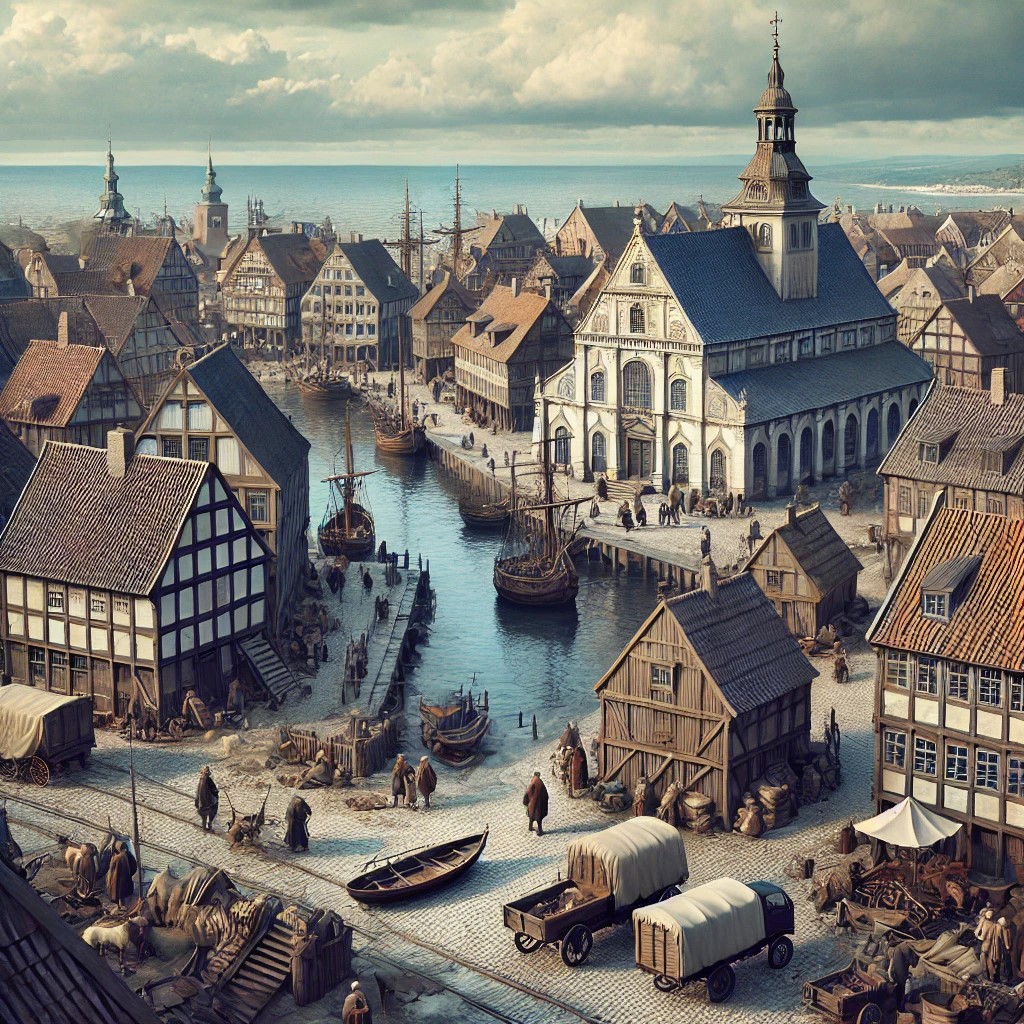Arhus
The county of Arhus, also Aarhus, is a coastal province of the Kingdom of Denmark and Norway, in eastern Jutland, Denmark, positioned along the Aarhus Bay of the Kattegat Sea. The town sits at the mouth of the Aarhus River, which has long served as a natural harbor, providing access to both inland waterways and maritime trade routes. The surrounding county covers approximately 2.8 hexes, with a population of 80,507.
Contents
Though not among the largest settlements in the Danish realm, its harbor along the Kattegat makes it an important stop for merchants, sailors and fishermen travelling between the Baltic and North Seas. The town's natural harbour, formed at the mouth of the Aarhus River, allows for steady maritime traffic, though most ships are of modest draft, suitable for coastal trade rather than deep-sea voyages. Although not a walled city, it is structured around a central market area, with narrow streets and timber-framed buildings clustered near the harbor and church. Beyond the town, scattered manorial estates, often owned by noble families or wealthy merchants, control large swaths of farmland and forest, operating on a mix of tenant labor and bonded peasants. The region serves as a gateway between the deeper Jutland interior and the maritime world of the Baltic.
Geography
The topography is varied, with low ridges and gentle valleys shaping the landscape. To the west and south, the land gradually rises, forming undulating moorlands and wooded areas, broken by small lakes and streams. The coastline is rugged in places, with rocky outcrops and narrow inlets, but much of it consists of sandy beaches and estuaries, making it well-suited for fishing and trade. Several rivers and streams crisscross the land, providing freshwater and natural boundaries, while small villages and farmsteads are scattered throughout, their fields following the gentle contours of the landscape.
The county’s forests, primarily oak and beech, provide ample timber resources, while the open meadows and pastures support livestock grazing. The inland areas feature peat bogs, a valuable source of fuel and preservation and pockets of heathland, which become more extensive farther west. The climate is cool and temperate, with mild summers and damp, windy winters, heavily influenced by the proximity of the North Sea and the Kattegat.
Culture
The people are practical and hardy, accustomed to the demands of a cool maritime climate and the challenges of an agricultural economy that relies on both inland crops and coastal harvests. Fishing communities along the Kattegat shore maintain a strong sense of kinship and mutual support, with knowledge of tides, currents and seasonal migrations of fish passed down through generations. Inland, tenant farmers and landowners coexist under a system of manorial control, where noble estates regulate much of the grain and livestock production. Arhus brings together a steady of Danish, German and Baltic influences. The long, dark winters foster a culture of storytelling and feasting, where sagas, folklore and superstitions about spirits, trolls and the unseen world remain an integral part of rural belief.
Social life in the region is structured around strong communal ties, where family, guilds and local assemblies dictate both work and leisure. The town’s central church serves as both a place of worship and a focal point for gatherings, where festivals and religious holidays punctuate the calendar. Though Lutheranism is dominant, older Norse traditions and folk beliefs persist in subtle ways, influencing rituals, charms and seasonal celebrations. Music and dance play an important role in local festivities, often accompanied by fiddles, drums and flutes, with performances at inns, farmsteads and town fairs. Feasting is a major aspect of social life, with meals built around bread, cheese, smoked fish and hearty stews, supplemented by mead and ale. Though the people of Arhus are not warlike, they maintain a pragmatic approach to self-defense, with village militias and town guards prepared to respond to raids or lawlessness, particularly along vulnerable coastal routes.
History
Arhus first emerged as a harbour town during the Viking Age, benefiting from its natural river outlet and its strategic location along the Kattegat coast, which allowed for steady maritime trade. While it never reached the prominence of Ribe or Hedeby, Aarhus maintained an important role as a waypoint, its market drawing merchants from Norway, the German lands and beyond. By the late medieval period, it had become an established town, shaped by both the commercial activity of its harbour and the ecclesiastical influence of its cathedral.
The 13th and 14th centuries saw the town solidify its role as a local trading hub, but it also endured periodic hardships due to conflicts, taxation and political upheaval. With the rise of the Hanseatic League, many of Denmark's trade centres became subject to German economic influence, though Aarhus remained more regionally focused, relying on agriculture, timber and fisheries to sustain its economy. In the 15th and early 16th centuries, the town continued to grow despite the turbulence of shifting royal policies and territorial disputes within the kingdom. The introduction of the Reformation in Denmark in the early 16th century led to Lutheranism displacing Catholic authority, bringing the dissolution of monastic orders and church-controlled landholdings, further altering the town's religious and economic landscape.
In more recent decades, under the reign of King Christian IV (1588–1648), Aarhus has experienced modest expansion, benefiting from royal policies aimed at strengthening Danish trade and infrastructure. However, the kingdom has also suffered from wars with Sweden and involvement in broader European conflicts, most notably during the Thirty Years' War (1618–1648). Although Jutland itself has seen incursions from Swedish and Imperial forces, Aarhus, while affected, has avoided total devastation. In the years following the war's conclusion, the town remains stable, continuing to function as an agricultural and trade centre, though its importance is still overshadowed by larger ports like Copenhagen and Aalborg. Now, in 1650, it stands as a prosperous but modest town, shaped by its deep maritime roots, its resilient people and the broader shifts in Danish politics and trade.
